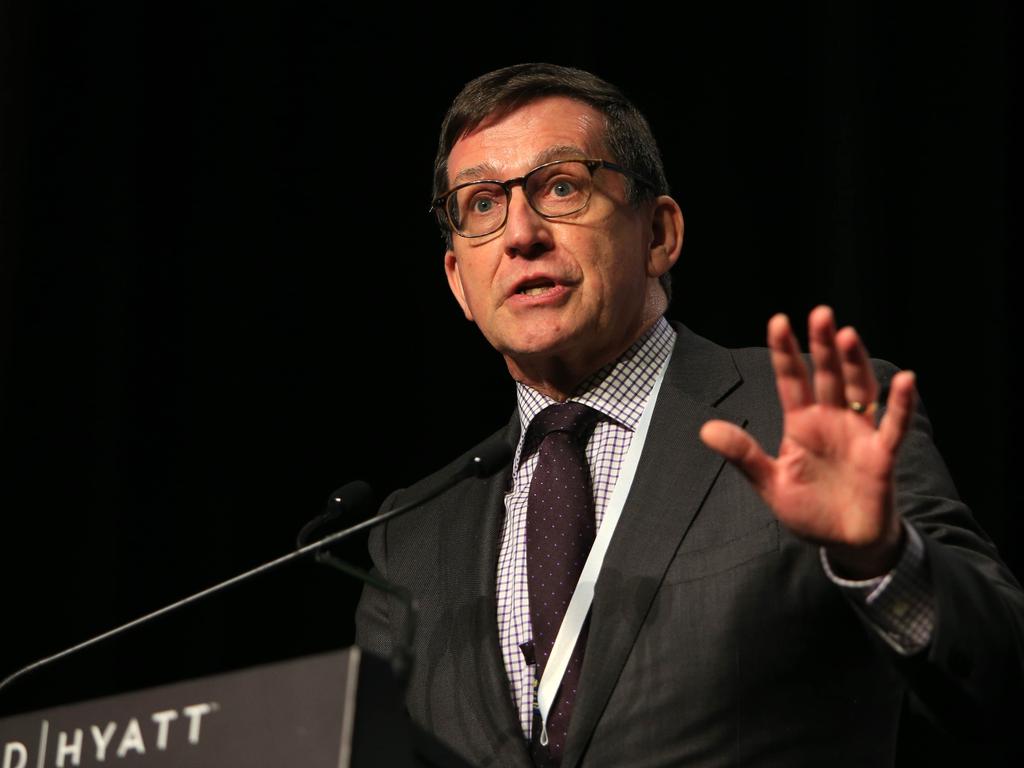RBA interest rate shock up-ends forecasts of big four banks
The Reserve Bank’s 50 basis-point rate hike on Tuesday has smashed the carefully built economic models of the country’s four major banks.
The Reserve Bank’s 50 basis-point rate hike on Tuesday has smashed the carefully built economic models of the country’s four major banks, causing growth forecasts to tumble and again playing havoc with share prices.
Commonwealth Bank – which had stuck resolutely to its expectation of a modest increase in the cash rate to a 1.6 per cent peak in mid-2023 – dramatically flipped on Thursday. Its economists now projects official rates will reach 2.1 per cent by the end of this year, and that the RBA will cut rates in the second half of 2023.
It correspondingly downgraded its GDP growth forecast for this year to 3.5 per cent from 4.7 per cent. Similarly, the 2023 growth target was slashed to 2.1 per cent from 3.1 per cent.
Last month at a trading update the bank’s chief executive, Matt Comyn, strongly endorsed the more optimistic house view. “The speculation about a cash rate the market is pricing in is, in our view, much higher than what is going to unfold,” Mr Comyn said at the time. “Our clear view is the inflation level is probably going to peak shortly, and inflation is a lagging indicator.”
But as the economist John Maynard Keynes once remarked: “When the facts change I change my mind. What do you do, sir?”
Mr Comyn would heartily agree, as would RBA governor Philip Lowe after he botched the central bank’s pandemic guidance that the cash rate would not increase until 2024. Announcing last month the first rate hike in official rates since 2010, Dr Lowe acknowledged that the error was “embarrassing” and that the RBA should have done better.
Forecasting, however, has never been an exact exercise, especially over the past few years in the pandemic as some governments effectively put entire economies into extended hibernation.
“It’s been close to impossible (to make accurate forecasts),” ANZ’s head of Australian economics David Plank said. “Border closures and lockdowns have made it harder, but also there hasn’t been a period of such elevated inflation and low real interest rates since the 1970s.
“So there’s very little recent experience to go on.”
This was little consolation for the major banks as share prices wilted on Thursday, shedding some $10.7bn. Losses over the last two days have exceeded $28bn.
Westpac again led the sector lower, giving up 81c, or 3.7 per cent, to $21.17. CBA was down 2.5 per cent to $94.95, while National Australia Bank and ANZ each dropped 2.3 per cent to $28.25 and $23.35 respectively.
CBA’s head of Australian economics, Gareth Aird, said in a report that there had been a “clear shift” in the RBA’s position, with Dr Lowe now noting the board would be “doing what is necessary” to bring inflation back within its 2-3 per cent range over time.
“The RBA has their work cut out for them on the inflation front as there is very little they can do to run against global factors that have pushed inflation higher, particularly in the energy and food space,” Mr Aird said. “Nonetheless, the RBA this week has signalled their intention to normalise policy quickly by raising the cash rate by a larger than usual 50bp.”
While economic booms could not run indefinitely, Mr Aird said not all of them had to end in a bust.
“Our expectation is that Australia’s current economic boom has a little further to run and the labour market will remain tight so we don’t foresee a bust,” he said.
“But growth momentum is anticipated to slow materially by late 2022 due to a swift and aggressive RBA tightening cycle.”
A deeply negative trend in real wages would also weigh on the volume of spending over the rest of 2022. However, a significant slowdown in output was different to a contraction, so talk of a recession was premature. Household savings rate remain elevated, leaving room for a decline in the savings rate to support consumption.
Growth overall was still expected to moderate to a below-trend pace over 2023. This would pull the rate of inflation down as unemployment edged higher.
The good news was that the RBA was not facing a wage-price spiral as in some other countries, so there was no need to aggressively hike the cash rate to counter wage growth. “Our previous profile for the cash rate to be gradually raised to 1.6 per cent by February 2023 reflected what we thought the RBA would deliver, which we also assessed to be the right policy path,” Mr Aird said. “But ultimately it does not matter what we think; it is about what they do.”






To join the conversation, please log in. Don't have an account? Register
Join the conversation, you are commenting as Logout